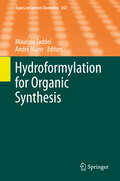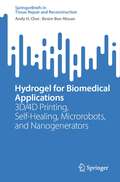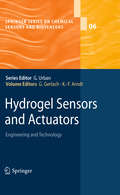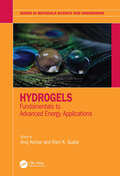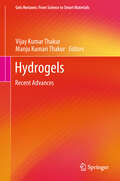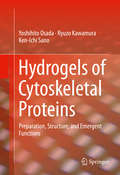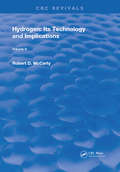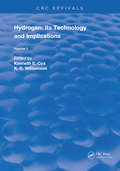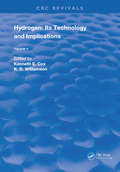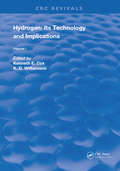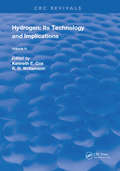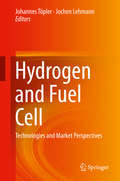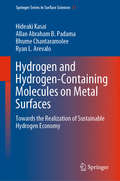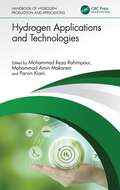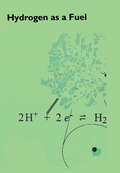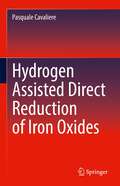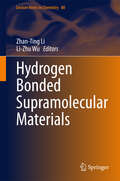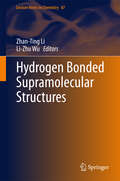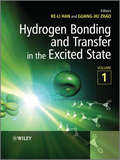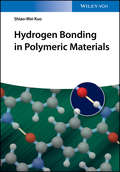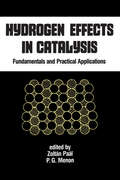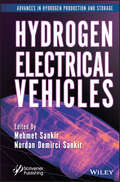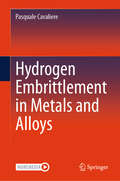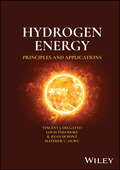- Table View
- List View
Hydroformylation for Organic Synthesis
by Maurizio Taddei André MannThe Role of Metals and Ligands in Organic Hydroformylation, by Luca Gonsalvi, Antonella Guerriero, Eric Monflier, Frédéric Hapiot, Maurizio Peruzzini. Hydroformylation in Aqueous Biphasic Media Assisted by Molecular Receptors, by Frédéric Hapiot, Hervé Bricout, Sébastien Tilloy, Eric Monflier. Asymmetric Hydroformylation, by Bernabé F. Perandones, Cyril Godard, Carmen Claver. Domino Reactions Triggered by Hydroformylation, by Elena Petricci, Elena Cini. Rhodium-Catalyzed Hydroformylation in Fused Azapolycycles Synthesis, by Roberta Settambolo. Hydroformylation in Natural Product Synthesis, by Roderick W. Bates, Sivarajan Kasinathan.
Hydrofunctionalization
by Masato Tanaka Valentine P. AnanikovValentine P. Ananikov, Irina P. Beletskaya: Alkyne and alkene insertion into metal-heteroatom and metal-hydrogen bonds - the key stages of hydrofunctionalization process.- Akihiko Ishii* and Norio Nakata: The Mechanism for Transition Metal-Catalyzed Hydrochalcogenation of Unsaturated Organic Molecules.- A. L. Reznichenko and Kai C. Hultzsch: Early Transition Metal (Group 3-5, Lanthanides and Actinides) and Main Group Metal (Group 1, 2, and 13) Catalyzed Hydroamination.- Naoko Nishina and Yoshinori Yamamoto: Late transition metal catalyzed hydroamination.- Sumod A. Pullarkat and Pak-Hing Leung: Chiral Metal Complex Promoted Asymmetric Hydrophosphinations.- Masato Tanaka: Recent Progress in Transition Metal-Catalyzed Addition Reactions of H-P(O) Compounds with Unsaturated Carbon Linkages.- Christian Bruneau: Group 8 metals-catalyzed O-H bond addition to unsaturated molecules.- Giorgio Abbiati, Egle M. Beccalli, Elisabetta Rossi: Groups 9 and 10 metals-catalyzed O-H bond addition to unsaturated molecules.- Núria Huguet and Antonio M. Echavarren: Gold-Catalyzed O-H Bond Addition to Unsaturated Organic Molecules.- Akiya Ogawa: Transition-Metal-Catalyzed S-H and Se-H Bonds Addition to Unsaturated Molecules.
Hydrogel for Biomedical Applications: 3D/4D Printing, Self-Healing, Microrobots, and Nanogenerators (Tissue Repair and Reconstruction)
by Andy H. Choi Besim Ben-NissanThis book highlights the latest clinical research and advancements in 3D (bio)printing and 4D printing using stimulus-responsive hydrogels as well as the concept of self-healing and its amalgamation with 3D printed injectable cell-laden tissue constructs. It also explores the use of metal-free “click” chemistry and enzymes such as horseradish peroxidase, hematin, tyrosinase, and transglutaminase to obtain chemically crosslinked hydrogels and the in vitro and in vivo responses. Lastly, the book briefly examines the future of drug delivery and the potentials offered by microrobotics and self-powered devices based on triboelectric nanogenerators. This book caters to biomedical researchers and clinical practitioners working in tissue reconstruction and drug/therapeutic delivery.
Hydrogel Sensors and Actuators
by Gerald Gerlach K. F. ArndtHydrogels are a fascinating class of polymers which show an immense ability of swelling under the influence of temperature, pH value or concentrations of different species in aqueous solutions. The volume change can amount up to several hundred percent. This unique behaviour is already used in such applications like disposable diapers, contact lenses or drug-delivery systems. The ability to perform mechanical work has been shifted the technical interest more and more towards sensors and actuators exploiting the thermo-chemo-mechano-electrical coupling within hydrogels. The accuracy requirements for such devices are much more demanding than for previous applications. Therefore, a deep knowledge of both the material and the functional properties of hydrogel sensors and actuators is needed. The monograph describes state of the art and recent developments for these materials in sensor and actuator technology.
Hydrogels: Fundamentals to Advanced Energy Applications (Series in Materials Science and Engineering)
by Anuj Kumar and Ram K. GuptaThe demand for advanced energy devices such as high-performance batteries, supercapacitors, fuel cells, electrolyzers, and flexible/wearable devices is increasing rapidly. To meet such demand, high-performance and stable materials that could be used as active materials in these devices are much needed. This book focuses on the use of hydrogels in such emerging applications. The main objective of this book is to provide current, state-of-the-art development in hydrogel-based materials, their applications in energy, and their future challenges. This book covers the entire spectrum of hydrogels for their applications in a range of energy devices in terms of materials, various synthetic approaches, architectural aspects, design and technology of energy devices, and challenges. This book covers the fundamentals of hydrogels, various composites of hydrogels, design concepts, different technologies, and applications in the diverse energy area. All chapters are written by experts in these areas around the world, making this a suitable textbook for students and providing new guidelines to researchers and industries working in these areas. This book includes topics such as various approaches to synthesizing hydrogels, their characterizations, and emerging applications in the energy area. Fundamentals of energy devices, working principles, and their challenges are also covered. This book will provide new directions to scientists, researchers, and students to better understand hydrogel-based materials and their emerging applications in energy.
Hydrogels: Recent Advances (Gels Horizons: From Science to Smart Materials)
by Vijay Kumar Thakur Manju Kumari ThakurThis book discusses recent advances in hydrogels, including their generation and applications and presents a compendium of fundamental concepts. It highlights the most important hydrogel materials, including physical hydrogels, chemical hydrogels, and nanohydrogels and explores the development of hydrogel-based novel materials that respond to external stimuli, such as temperature, pressure, pH, light, biochemicals or magnetism, which represent a new class of intelligent materials. With their multiple cooperative functions, hydrogel-based materials exhibit different potential applications ranging from biomedical engineering to water purification systems. This book covers key topics including superabsorbent polymer hydrogel; intelligent hydrogels for drug delivery; hydrogels from catechol-conjugated materials; nanomaterials loaded hydrogel; electrospinning of hydrogels; biopolymers-based hydrogels; injectable hydrogels; interpenetrating-polymer-network hydrogels: radiation- and sonochemical synthesis of micro/nano/macroscopic hydrogels; DNA-based hydrogels; and multifunctional applications of hydrogels. It will prove a valuable resource for researchers working in industry and academia alike.
Hydrogels of Cytoskeletal Proteins
by Yoshihito Osada Ryuzo Kawamura Ken-Ichi SanoThis book describes a new family of bio-polymergels made from cytoskeletal proteins - actin, microtubule, andtropomyosin. The importance of the gelstate with multi-scale hierarchical structure is emphasized to utilize emergentfunctions in living organisms. Detailed protocol of gel preparation, specifiedmethod of structure investigation, and dynamic studies of self-organization,self-healing, synchronized oscillating, and autonomous motility functions areintroduced together with biomimeticfunctions of synthetic hydrogels.
Hydrogen: Hydrogen Properties - Volume III
by CoxVolume II of this series provides detailed design information on systems necessary for the storage, transfer, and transmission of gaseous and liquid hydrogen.Cost factors, technical aspects, and models of hydrogen pipeline systems are included together with a discussion of materials for hydrogen service. Metallic hydride gaseous storage systems for the utility and transportation industry are covered in detail, and the design Dewars and liquid hydrogen transfer systems are examined.This series in 5 volumes represents a serious attempt at providing information on all aspects of hydrogen at the postgraduate and professional level. It discusses recent developments in the science and technology of hydrogen production; hydrogen transmission and storage; hydrogen utilization; and the social, legal, political environmental, and economic implications of hydrogen‘s adoption as an energy medium.
Hydrogen: Transmission and Storage - Volume II
by Kenneth E. Cox K.D. WilliamsonVolume II of this series provides detailed design information on systems necessary for the storage, transfer, and transmission of gaseous and liquid hydrogen.Cost factors, technical aspects, and models of hydrogen pipeline systems are included together with a discussion of materials for hydrogen service. Metallic hydride gaseous storage systems for the utility and transportation industry are covered in detail, and the design Dewars and liquid hydrogen transfer systems are examined.This series in 5 volumes represents a serious attempt at providing information on all aspects of hydrogen at the postgraduate and professional level. It discusses recent developments in the science and technology of hydrogen production; hydrogen transmission and storage; hydrogen utilization; and the social, legal, political environmental, and economic implications of hydrogen‘s adoption as an energy medium.
Hydrogen: Implication of Hydrogen Energy - Volume V
by Kenneth E. Cox K.D. WilliamsonVolume V of this series is primarily concerned with the nontechnical aspects of hydrogen. Economics of hydrogen energy systems will play a major part in determining the time frame for hydrogen‘s adoption. Cost analyses of such systems with return on investment considerations are surveyed from the point of view of production, transmission, and storage of hydrogen. The environmental, political, social, and legal implications of new secondary energy forms such as hydrogen are discussed with reference to governmental energy policy, the social costs of energy production and use, and the public‘s acceptance of a hydrogen energy medium.This series in 5 volumes represents a serious attempt at providing information on all aspects of hydrogen at the postgraduate and professional level. It discusses recent developments in the science and technology of hydrogen production; hydrogen transmission and storage; hydrogen utilization; and the social, legal, political environmental, and economic implications of hydrogen‘s adoption as an energy medium.
Hydrogen: Production Technology - Volume I
by R I CoxVolume I of this series discusses such topics as hydrogen production from fossil fuels, nuclear energy, and solar energy. Hydrogen production technology from water by traditional methods such as water electrolysis and newer attempts to split water thermochemically are included with details of current research efforts and future directions.This series in 5 volumes represents a serious attempt at providing information on all aspects of hydrogen at the postgraduate and professional level. It discusses recent developments in the science and technology of hydrogen production; hydrogen transmission and storage; hydrogen utilization; and the social, legal, political environmental, and economic implications of hydrogen‘s adoption as an energy medium.
Hydrogen: Utilization of Hydrogen - Volume IV
by Kenneth E. Cox and K. D. WilliamsonVolume IV of this series covers the present and future uses of hydrogen. Hydrogen has been suggested as a prime candidate for both air and surface transportation. Both present and future domestic and industrial applications of hydrogen are surveyed. Important to all of these applications are the safety considerations in the use of hydrogen to allow for public acceptance of hydrogen‘s role as an energy medium.This series in 5 volumes represents a serious attempt at providing information on all aspects of hydrogen at the postgraduate and professional level. It discusses recent developments in the science and technology of hydrogen production; hydrogen transmission and storage; hydrogen utilization; and the social, legal, political environmental, and economic implications of hydrogen‘s adoption as an energy medium.
Hydrogen and Fuel Cell
by Johannes Töpler Jochen LehmannThis book introduces readers to hydrogen as an essential energy carrier for use with renewable sources of primary energy. It provides an overview of the state of the art, while also highlighting the developmental and market potential of hydrogen in the context of energy technologies; mobile, stationary and portable applications; uninterruptible power supplies and in the chemical industry. Written by experienced practitioners, the book addresses the needs of engineers, chemists and business managers, as well as graduate students and researchers.
Hydrogen and Hydrogen-Containing Molecules on Metal Surfaces: Towards the Realization of Sustainable Hydrogen Economy (Springer Series in Surface Sciences #71)
by Hideaki Kasai Allan Abraham Padama Bhume Chantaramolee Ryan L. ArevaloThis book is dedicated to recent advancements in theoretical and computational studies on the interactions of hydrogen and hydrogenated molecules with metal surfaces. These studies are driven by the development of high-performance computers, new experimental findings, and the extensive work of technological applications towards the realization of a sustainable hydrogen economy. Understanding of the elementary processes of physical and chemical reactions on the atomic scale is important in the discovery of new materials with high chemical reactivity and catalytic activity, as well as high stability and durability. From this point of view, the book focuses on the behavior of hydrogen and hydrogenated molecules on flat, stepped, and reconstructed metal surfaces. It also tackles the quantum mechanical properties of hydrogen and related adsorbates; namely, molecular orbital angular momentum (spin) and diffusion along the minimum potential energy landscape on metal surfaces. All of these profoundly influence the outcomes of (1) catalytic reactions that involve hydrogen; (2) hydrogen storage in metals; and (3) hydrogen purification membranes. Lastly, it surveys the current status of the technology, outlook, and challenges for the long-desired sustainable hydrogen economy in relation to the topics covered in the book.
Hydrogen Applications and Technologies
by Mohammad Reza Rahimpour Mohammad Amin Makarem Parvin KianiHydrogen has wide applications across many industries, including petroleum refineries, hydrotreating processes, and metallurgy applications. In addition, a number of valuable chemicals, such as ammonia, alcohols, and acids, are manufactured directly or indirectly with hydrogen. Hydrogen Applications and Technologies covers the utilization of hydrogen in petrochemical products, vehicles, and power generation systems, as well as in refinery hydrotreating, metallurgy, welding, annealing, and the heat‑treating of metals. Describes the application of hydrogen in producing valuable chemicals in detail Comprehensively discusses hydrogen utilization as an energy source Covers the application of hydrogen in power generation systems and across various industries Reviews hydrogen’s role as an agent in chemical reactions Part of the multivolume Handbook of Hydrogen Production and Applications, this stand-alone book guides researchers and academics in chemical, environmental, energy, and related areas of engineering interested in development and implementation of hydrogen production technologies.
Hydrogen as a Fuel: Learning from Nature
by Richard Cammack Michel Frey Robert RobsonThere continues to be widespread interest in the applications of hydrogen as a clean fuel and its potential for local electricity production and use in transport. Recent years have seen a variety of breakthroughs in our understanding of the nature, structure, and biosynthesis of hydrogenases. This book is a timely description of these developments,
Hydrogen Assisted Direct Reduction of Iron Oxides
by Pasquale CavaliereThe book describes the main approaches to produce and synthesize iron and steel through hydrogen-based technologies. Depending on the processing route and on the energy demand, the best available techniques and the most forward-looking solutions are explained. The book is edited with the contribution representing a range of industries in order to evaluate the industrial feasibility of each selected technology. It presents the most efficient solutions applied by ironmaking and steelmaking factories all around the world.
Hydrogen Bonded Supramolecular Materials
by Zhan-Ting Li Li-Zhu WuThis book is an up-to-date text covering topics in utilizing hydrogen bonding for constructing functional architectures and supramolecular materials. The first chapter addresses the control of photo-induced electron and energy transfer. The second chapter summarizes the formation of nano-porous materials. The following two chapters introduce self-assembled gels, many of which exhibit unique functions. Other chapters cover the advances in supramolecular liquid crystals and the versatility of hydrogen bonding in tuning/improving the properties and performance of materials. This book is designed to bring together in a single volume the most important and active fields of hydrogen bonding strategy for designing supramolecular materials. The book will be a valuable resource for graduates and researchers working in the fields of supramolecular chemistry and materials sciences. Zhan-Ting Li, PhD, is a Professor of Organic Chemistry at the Department of Chemistry, Fudan University, China Li-Zhu Wu, PhD, is a Professor of Organic Chemistry at the Technical Institute of Physics and Chemistry, Chinese Academy of Sciences, China
Hydrogen Bonded Supramolecular Structures
by Zhan-Ting Li Li-Zhu WuThis book covers the advances in the studies of hydrogen-bonding-driven supramolecular systems made over the past decade. It is divided into four parts, with the first introducing the basics of hydrogen bonding and important hydrogen bonding patterns in solution as well as in the solid state. The second part covers molecular recognition and supramolecular structures driven by hydrogen bonding. The third part introduces the formation of hollow and giant macrocycles directed by hydrogen bonding, while the last part summarizes hydrogen bonded supramolecular polymers. This book is designed to bring together in a single volume the many important aspects of hydrogen bonding supramolecular chemistry and will be a valuable resource for graduates and researchers working in supramolecular and related sciences. Zhan-Ting Li, PhD, is a Professor of Organic Chemistry at the Department of Chemistry, Fudan University, China. Li-Zhu Wu, PhD, is a Professor of Organic Chemistry at the Technical Institute of Physics and Chemistry, Chinese Academy of Sciences, China.
Hydrogen Bonding and Transfer in the Excited State
by Guang-Jiu Zhao Ke-Li HanThis book gives an extensive description of the state-of-the-art in research on excited-state hydrogen bonding and hydrogen transfer in recent years.Initial chapters present both the experimental and theoretical investigations on the excited-state hydrogen bonding structures and dynamics of many organic and biological chromophores. Following this, several chapters describe the influences of the excited-state hydrogen bonding on various photophysical processes and photochemical reactions, for example: hydrogen bonding effects on fluorescence emission behaviors and photoisomerization; the role of hydrogen bonding in photosynthetic water splitting; photoinduced electron transfer and solvation dynamics in room temperature ionic liquids; and hydrogen bonding barrier crossing dynamics at bio-mimicking surfaces. Finally, the book examines experimental and theoretical studies on the nature and control of excited-state hydrogen transfer in various systems.Hydrogen Bonding and Transfer in the Excited State is an essential overview of this increasingly important field of study, surveying the entire field over 2 volumes, 40 chapters and 1200 pages. It will find a place on the bookshelves of researchers in photochemistry, photobiology, photophysics, physical chemistry and chemical physics.
Hydrogen Bonding in Polymeric Materials
by Shiao-Wei KuoSummarizing our current knowledge of the topic, this book describes the roles and effects of hydrogen bonding in polymer materials by reviewing the latest developments over recent years. To this end, it discusses all relevant aspects from the fundamentals, via characterization, to properties and applications in various polymeric materials, including polymer blends, block copolymers, mesoporous materials, biomacromolecules and nanocomposites. Invaluable reading for scientists in polymers and materials as well as those working in macromolecular chemistry.
Hydrogen Effects in Catalysis: Fundamentals and Practical Applications
by Zoltan Paal P.G. MenonThis book covers hydrogen effects in catalysis in the broadest sense, from surface science to industrial applications. It draws the attention of the catalysis community to the importance of the phenomena of hydrogen effects both in the science and technology of catalysis.
Hydrogen Electrical Vehicles (Advances in Hydrogen Production and Storage (AHPS))
by Mehmet Sankır Nurdan SankirHYDROGEN ELECTRICAL VEHICLES Hydrogen electrical vehicles are an essential component of the “Green New Deal” and this book covers cutting-edge technologies designed for fuel-cell-powered cars. The realization of the decision of 28 countries to keep global warming at 2 degrees and below, which is stated in the Paris Agreement, and the achievement of minimizing CO2 emissions, can only be accomplished by establishing a hydrogen ecosystem. A new geopolitical order is envisaged, in which sectors dealing with energy production, distribution, and storage, thus decreasing the carbon footprint, are reconstructed. In short, an economic order with new tax regulations is being created in which the carbon footprint will be followed. This global effort called the “Green Deal” is defined as a new growth strategy aiming at net-zero CO2 emissions. We know that the total share of transportation in CO2 emissions is about 24%. Therefore, efforts for reducing emissions must include utilizing hydrogen in transport. The subjects covered in the book include: An introduction to hydrogen and electrical vehicles; Hydrogen storage and compression systems; Hydrogen propulsion systems for UAVs; Test and evaluation of hydrogen fuel cell vehicles; Hydrogen production and PEM fuel cells for electrical vehicles; The power and durability issues of fuel cell vehicles. Audience The book will attract readers from diverse fields such as chemistry, physics, materials science, engineering, mechanical and chemical engineering, as well as energy-focused engineering and hydrogen generation industry programs that will take advantage of using this comprehensive review of the hydrogen electrical vehicles.
Hydrogen Embrittlement in Metals and Alloys
by Pasquale CavaliereThis book provides a complete description of hydrogen technologies from the basic theoretical underpinnings to the different production routes for various applications. It summarizes the most recent research findings with respect to theory and the broad array of industrial technologies currently in place as well as those under development with high potential. Special attention is given to the hydrogen embrittlement mechanisms at room and high temperatures as well as problems related to hydrogen in liquid and high-pressure compressed states. The author further describes the hydrogen diffusion embrittlement issues related to different types of metallic materials from steel to light alloys to nikel-based superalloys.
Hydrogen Energy: Principles and Applications
by Vincent J. DelGatto Louis Theodore R. Ryan Dupont Matthew C. OgwuUnderstand hydrogen as an energy resource and its potential as a dynamic solution for a carbon-neutral economy Hydrogen is an energy carrier that can be used to store, move, and deliver energy produced from other sources. It has the potential for high energy efficiency, significant environmental and social benefits, and economic competitiveness. Traditional energy resources will not be able to meet the growing energy demand, despite the advances in energy management and energy conservation—understanding how hydrogen energy can solve this problem is crucial. Hydrogen Energy: Principles and Applications provides the information needed by energy resource planners, scientists, engineers, and government officials to make informed energy-related decisions. Divided into three parts, the book opens with an introduction to various energy issues, sources, and regulations, including the basics of thermodynamics and fuel cells. The second part addresses the practical aspects of hydrogen energy, such as availability, distribution, extraction, processing, purification, transportation, transmission, and storage. The final section details the economics, energy-environmental interactions, and ethical and political considerations of the development and use of hydrogen energy, including discussion of investment and business contacts, energy option analysis and optimization, and future prospects. Covering the fundamentals of hydrogen energy with a thorough and accessible approach, the book: Equips readers with a well-rounded working knowledge of hydrogen energy Covers the latest technological advances, economic considerations, and the role hydrogen plays in a renewable energy economy Offers a pragmatic, real-world perspective rather than focusing on theoretical issues Contains nearly 50 illustrative examples ranging from elementary thermodynamic calculations to optimization applications using linear programming Hydrogen Energy: Principles and Applications is a must-read for those working in the energy industry, particularly environmental engineering and science professionals, as well as government officials, policymakers, instructors, and trainers involved in energy-related fields.
